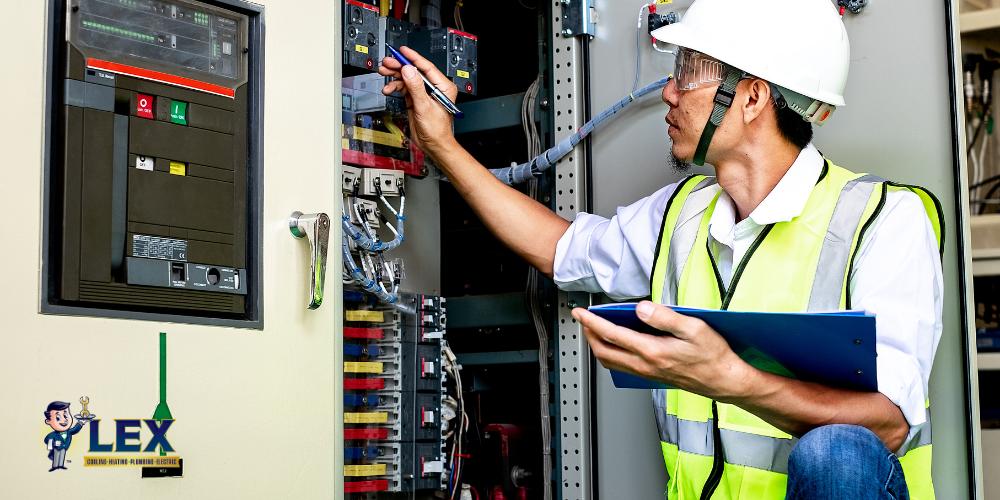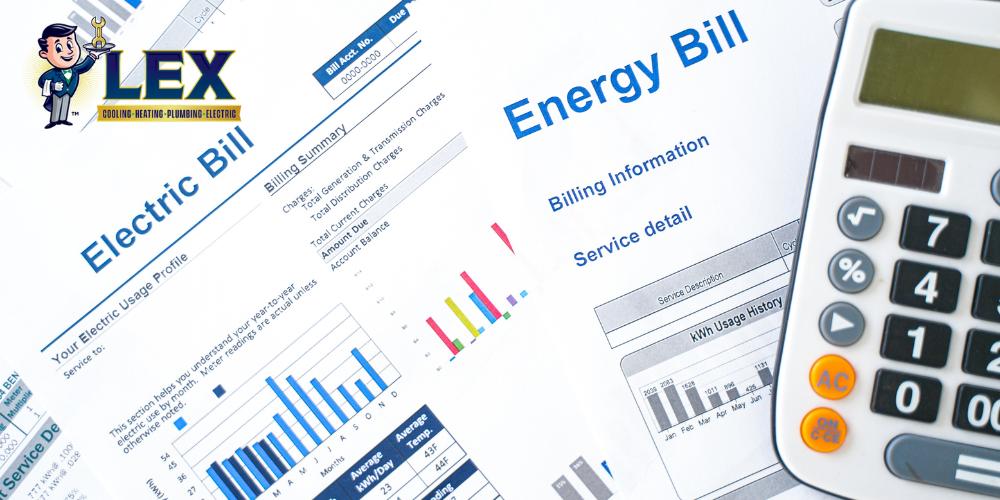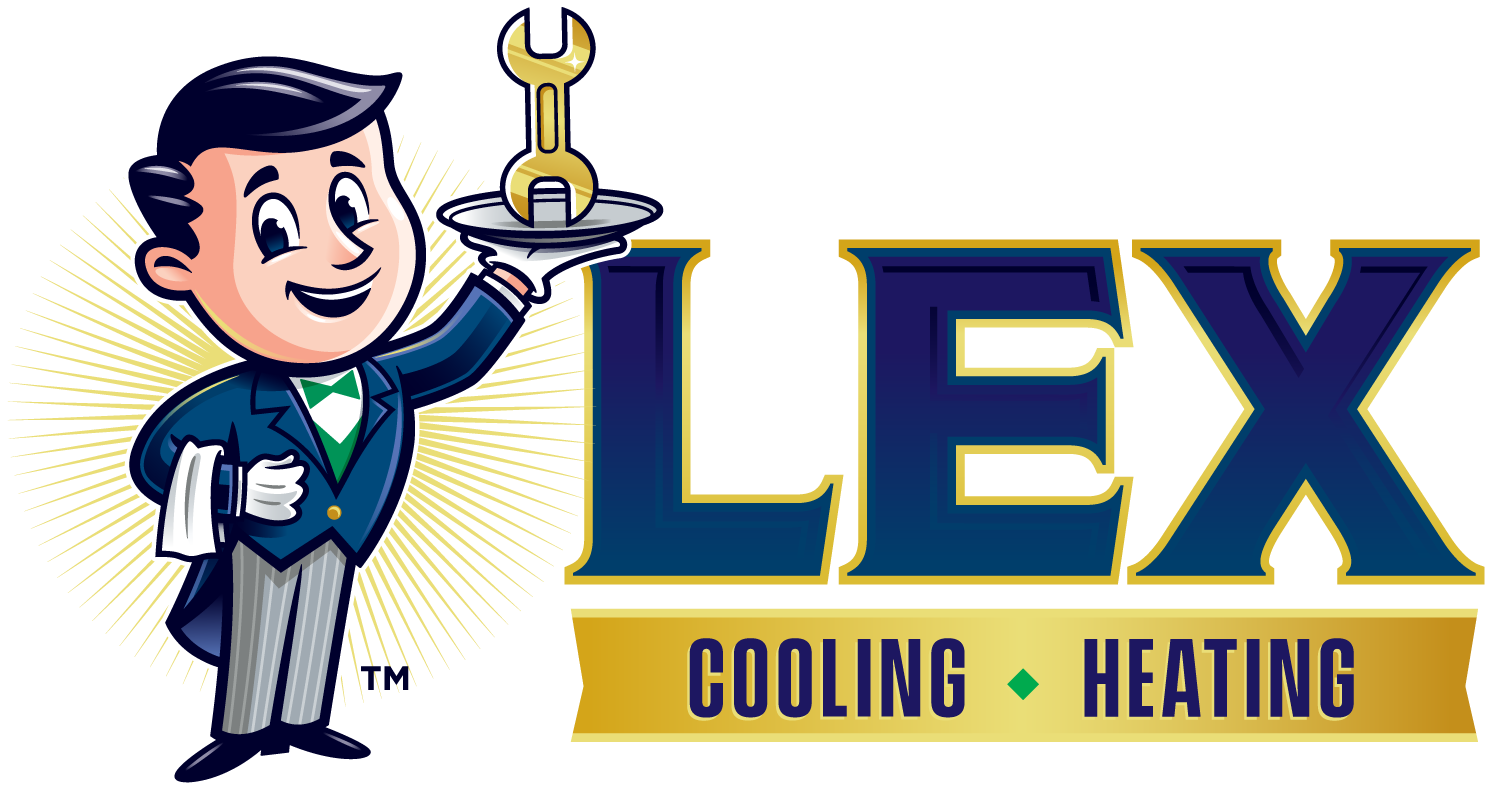Understanding which appliances and systems consume the most electricity is key to managing monthly energy bills, especially in East Texas, where long, humid summers can push air conditioning costs to nearly half of a household’s total energy use. The biggest electricity consumers typically include HVAC systems, water heaters, refrigerators, clothes dryers, lighting, and home electronics. When these systems are outdated or inefficient, they draw more power than necessary, leading to higher utility bills.
At Lex Air East Texas, our experienced electricians in Tyler, TX can help you identify these problem areas through energy assessments, efficiency upgrades, and electrical inspections. We ensure your home’s systems operate safely and efficiently, reducing waste and lowering your long-term energy costs.
Understanding Your Energy Use
Pinpointing your home’s largest energy consumers allows you to make smart, cost-effective improvements. Inefficient HVAC units, outdated water heaters, and older major appliances are some of the most common culprits behind high electric bills. Replacing these with energy-efficient models, installing smart thermostats, or upgrading to Energy Star Certified appliances can dramatically reduce consumption while maintaining comfort.
By understanding how each system contributes to your total energy use, you can prioritize upgrades that have the biggest impact on monthly costs. This knowledge empowers homeowners to invest strategically—whether that means improving insulation, upgrading ductwork, or modernizing appliances—to achieve long-term energy savings and a more efficient, comfortable home environment.
How Much Electricity Does the Average Home Use in Tyler, Texas?
The average household in Tyler, Texas, uses roughly 1,100 kilowatt-hours (kWh) of electricity per month, well above the national average of about 886–899 kWh. The primary reason is East Texas’s warm, humid climate, which demands frequent air conditioning use for much of the year.
With Tyler’s average residential electricity rate of about 14¢ per kWh, that usage translates to an estimated monthly bill of around $154. These higher energy demands highlight the importance of regular HVAC maintenance, modern electrical upgrades, and efficient home design. By improving your home’s insulation, scheduling professional HVAC tune-ups, and switching to efficient lighting and appliances, you can significantly reduce energy costs without compromising comfort.

What Appliances Use the Most Electricity?
While most homeowners are aware that running multiple appliances throughout the day contributes to their monthly electricity bill, many don’t realize just how much energy certain devices use. Heating and cooling equipment account for up to 47% of a home’s annual electricity consumption, making HVAC systems the largest energy consumer, followed by water heating, which accounts for approximately 18% of household energy use.
The electrical appliances that use the most energy tend to be those that generate heat, such as clothes dryers, dishwashers, and countertop cooking appliances. However, major appliances like refrigerators also contribute significantly to your monthly energy consumption.
Air Conditioning and Heating Systems
It’s safe to say that what uses the most electricity in a home in Texas is the HVAC system. Air conditioning systems are the top contributor to high electricity bills in Texas homes, with cooling costs accounting for 28% of electricity consumption. Approximately 95% of Texas households use air conditioning due to the state’s high temperatures.
Air conditioners typically use between 3,000 and 5,000 watts of electricity per hour when running, translating to about 15-25 kWh of energy per day for a standard central AC system. Poor maintenance and outdated HVAC systems contribute a significant portion of these costs, as dirty air filters cause heating and cooling systems to work harder to distribute air throughout the home. In contrast, regular HVAC maintenance and more efficient models can reduce energy consumption by 5-15%.
Electric Water Heaters
Electric water heaters consume substantial amounts of electricity to maintain the water heater’s temperature, typically ranking as the second-highest in a typical home’s energy use after HVAC systems. For homes that use 41 gallons or less of hot water daily, tankless water heaters can be 24%–34% more energy efficient than conventional storage tank water heaters.
Tankless units use less electricity overall because they don’t spend energy keeping hot water on standby, while traditional tank heaters must continuously maintain water temperature even when not in use, leading to significant standby energy losses. The Department of Energy estimates that an electric tankless water heater reduces energy costs by $44 per year compared to conventional tank models, making the choice between tank and tankless systems an important factor in managing your home’s energy consumption for water heating.
Washing Machines & Dryers
Laundry appliances are among the most electricity-hungry devices in your home, with washing machines using 0.3 to 2.0 kWh per load on average, while electric dryers consume significantly more, using anywhere from 1.8 to 5 kWh per cycle depending on load size and drying time. The average estimate is around 1.5 kWh per washing cycle (around 30 cents) and 4.5 kWh per drying cycle (around 90 cents), making dryers particularly costly since they generate heat to remove moisture from clothing.
This means a typical household doing just two loads of laundry per week can use 12 kWh over 4 hours of drying time, which explains why many homeowners notice significant spikes in their electricity bills during periods of heavy laundry use. The substantial difference in energy consumption between washing and drying highlights why using energy-efficient appliances and settings, proper load sizing, and alternative drying methods when possible can meaningfully impact your monthly electricity costs.
Electric Ovens and Cooktops
Electric cooking appliances are surprisingly significant contributors to your monthly electricity bill due to their high wattage requirements and frequent daily energy use in most households. Electric ovens typically consume between 2,000 and 5,000 watts when in use. A 3,000-watt oven costs about 36¢ per hour at high heat. Cooktop burners range from 1,200 watts for smaller burners to higher wattages for larger ones.
Based on average usage patterns, electric ovens consume approximately 1,022 kWh per year. When combined with daily stovetop cooking, these appliances can easily add $10-20 or more to your monthly energy bill, depending on your cooking habits. The frequent energy use of these high-wattage appliances throughout the day means that even efficient cooking practices and choosing appropriately sized burners for your cookware can result in meaningful savings.
Refrigerators and Freezers
The age of your refrigerator plays a dramatic role in your monthly electricity costs, as energy efficiency improvements over the past two decades have created substantial differences in power consumption between older and newer models. A 20-year-old refrigerator could use 1,700 kWh of electricity per year, compared with about 450 kWh for a similarly sized, new, energy-efficient model, representing a potential savings of $150 per year at typical electricity rates.
On average, an old refrigerator uses about 35% more energy than an Energy Star-certified model. Meanwhile, an 18-cubic-foot refrigerator from the 1980s is likely to consume around 1,400 kWh of electricity per year, almost four times more energy use than newer models. Modern refrigerators achieve this optimal efficiency through better insulation, advanced compressor technology, and improved temperature controls, making the replacement of older units one of the most impactful energy-saving upgrades homeowners can make.
Lighting and Other Small Devices
While lighting and small appliances may seem insignificant compared to central systems like HVAC, the cumulative effect of these devices can meaningfully impact your monthly electricity bill, especially when considering the dramatic efficiency differences between lighting technologies. A typical LED light bulb uses about 10 watts compared to about 60 watts for most incandescent bulbs, with an incandescent bulb used for 2 hours per day consuming 43.8 kilowatt-hours of electricity per year, versus just 7.3 kWh for an equivalent LED, which is why our professional LED installation services in Tyler help homeowners save money while improving illumination quality.
Small appliances and electronics also contribute to “vampire energy” consumption, where devices continue to draw power even when not actively in use, accounting for 5-10% of the total energy used in your home and potentially adding up to $50-100 annually in wasted electricity costs.

Hidden Energy Wasters That Increase Your Electricity Bills
Beyond obvious energy consumers like HVAC systems and major appliances, your home likely harbors numerous hidden energy wasters that silently drain electricity and inflate your monthly bills without providing any value. These invisible energy drains include everything from air leaks and poor insulation, which force your HVAC system to work harder, to dirty air filters that restrict airflow and increase system strain.
One of the most significant hidden culprits is “vampire power” or phantom loads, where devices consume energy even when turned off, accounting for up to 20-25% of your monthly electricity costs.
Air Leaks and Poor Insulation
Air leaks and inadequate insulation force your HVAC system to work harder to maintain comfortable temperatures. Drafts and leaks can waste $200–$400 annually from the average American’s energy spending by allowing conditioned air to escape before it reaches living spaces. Proper air sealing can cut energy bills by 10–20%. Sealing leaks and adding insulation to your home can reduce annual energy costs by up to 10% by preventing your heating and cooling systems from constantly cycling to make up for lost air.
Electrical solutions, such as ceiling fan installation, can further reduce this burden. Attic fans, for example, can lower electric bills by as much as 30% by preventing air conditioner cycling and keeping your attic within 10°F of the outside temperature.
Dirty or Clogged Air Filters
Dirty or clogged air filters are one of the most common—and easily preventable—causes of high electricity bills in Texas homes. A blocked filter restricts airflow, forcing your HVAC system to work harder to circulate air throughout your home. This added strain not only drives up energy consumption but also increases wear on vital components, leading to potential system failure.
In fact, a clogged air filter can raise your electricity usage by up to 15%, as the system requires more power to maintain proper airflow. The harder your fan motor works, the more energy it consumes, resulting in higher utility bills and reduced indoor comfort.
Replacing your air filter regularly is one of the simplest and most cost-effective ways to improve energy efficiency and extend the life of your HVAC system. Clean filters allow air to move freely, reduce stress on your equipment, and help maintain consistent temperatures throughout your home, all while lowering your monthly energy costs.
Phantom Energy Use from Electronics and Chargers
Phantom energy use refers to the electricity usage that electronic devices and chargers continue to draw even when they appear to be off or not actively in use, creating a constant but often unnoticed drain on electricity in your home. Phantom energy is prevalent in every household, from the charger left plugged in without a phone to the microwave clock that never sleeps, with each device maintaining standby power for features like instant-on capability, digital displays, or remote control responsiveness.
Common phantom load culprits include:
- Cable boxes that never fully power down
- Gaming consoles in sleep mode
- Coffee makers with digital clocks
- Devices with LED status lights or wireless connectivity that remain in standby mode 24/7

How Lex East Can Help You Improve Energy Efficiency With Expert Electrical Services in East Texas
While understanding what consumes the most electricity in your home is the first step toward managing your energy costs, implementing effective solutions requires the expertise of qualified electrical professionals who can assess your specific situation and recommend targeted improvements.
There are numerous proven strategies to reduce your home’s energy consumption, from upgrading to energy-efficient LED lighting systems and installing programmable thermostats to addressing phantom loads with smart power strips and improving your electrical infrastructure to support high-efficiency appliances.
At Lex East, our experienced Tyler electricians specialize in comprehensive energy efficiency solutions that can significantly lower your monthly electricity bills, including professional assessments to identify hidden energy wasters, expert installation of energy-saving electrical systems, and electrical upgrades that optimize your home’s overall performance.
Electrical Inspections and Energy Audits
Electrical inspections are comprehensive safety assessments conducted by licensed electricians to ensure your home’s electrical system meets current safety codes and identify potential hazards before they become costly or dangerous problems. Our Tyler, TX electrical inspection services include testing your electrical panel, evaluating wiring condition, checking for proper ground fault circuit interrupter protection, verifying tight connections, inspecting for burn marks or corrosion, and ensuring all components comply with Texas and local safety requirements.
Energy audits, also known as energy assessments, provide a comprehensive top-to-bottom evaluation of where your home is wasting energy and include specialized equipment testing to identify the factors that use the most electricity, as well as cost-effective ways to save energy.
Installing Energy Efficient Products and Smart Systems
Installing smart technologies, such as programmable thermostats, lighting controls with motion detectors, and surge protection systems, can dramatically reduce your monthly electricity costs. Smart thermostats alone can save approximately 8% of heating and cooling bills, or about $50 per year.
Upgrading outdated electrical panels also enhances safety, improves electrical capacity, and increases energy efficiency, while whole-house rewiring saves energy, boosts home value, ensures code compliance, and supports modern electrical needs. A modern panel can better handle the electrical load of contemporary appliances and devices, reducing the risk of energy waste and minimizing the likelihood of costly electrical repairs stemming from outdated systems, making these electrical infrastructure upgrades essential investments for long-term energy savings in your East Texas home.
Why Families in Tyler, Texas, Trust Lex East for Electrical Services
Lex East has built a reputation for excellence through consistent quality craftsmanship and commitment to customer satisfaction throughout East Texas. Our team of fully licensed and experienced electricians brings years of specialized knowledge to every project. We understand that electrical work directly impacts both your family’s safety and your monthly energy costs, which is why our professionals prioritize identifying energy-saving opportunities while ensuring every installation and repair meets the highest safety standards.

Call Lex East to Lower Your Energy Bills Today
High electricity bills are often caused by inefficiencies hidden in your home’s most-used systems. Understanding what uses the most electricity in a home—including major appliances, lighting, and HVAC systems—is the first step toward saving electricity in East Texas. Many homeowners are surprised to learn that heating, cooling, and water heating account for the majority of a home’s energy usage, while outdated wiring or overworked systems quietly drive up costs.
At Lex, our licensed electric, plumbing, and HVAC contractors in Tyler, Texas provide expert solutions to improve efficiency, reduce unnecessary energy waste, and teach you how to save on your electric bill in Texas. Our team performs comprehensive electrical assessments to pinpoint high-consumption areas, upgrade critical systems, and recommend improvements tailored to your home’s specific needs.
Don’t let rising electricity bills strain your budget. Contact Lex East today at (903) 650-9636 or contact us online to schedule your consultation and learn how our decade of experience can help you achieve lasting savings through targeted electrical and energy-efficiency upgrades.

